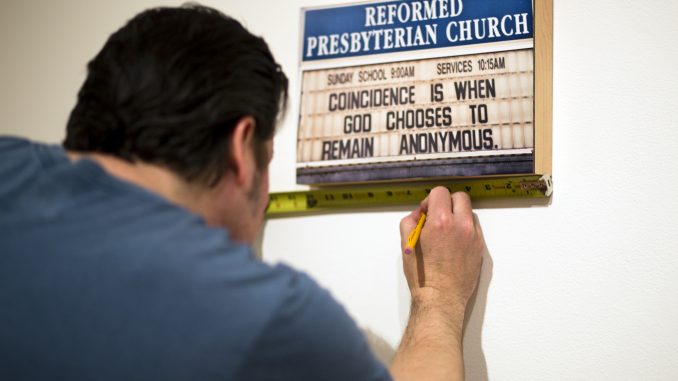
Dr. J. Susan Isaacs has an incessantly overflowing email inbox.
“I get sent stuff every day from all over the world,” Isaacs said. “All the time.”
But Isaacs said she welcomes the emails – she wants to know what’s going on.
“The Internet, I think, has made more of a democratization of the process of the art world,” Isaacs said.
An active art historian, painter, professor at Towson University outside of Baltimore and gallery curator of hundreds of shows, Isaacs said she is constantly on the lookout for her next focal point for a prospective exhibition.
A product of Isaacs’ extensive research and the work of several contemporary artists will be on display at the “And the Word Is…” exhibit at the Gershman Y on South Broad Street, from Jan. 22 until May 14.
The show revolves around varying portrayals of religious texts, ranging from antique Bibles bound with gold leaf edges to illuminated manuscripts of the Quran.
“It always starts from the artwork for me,” she said. “I don’t have an idea and look for the artwork – there’s artwork that creates the kernel of the idea.”

Isaacs first came across that “kernel” when artist Stephanie Kirk submitted a portfolio of photos to the Delaware Center for the Contemporary Arts several years ago. Before she began snapping photographs, Kirk’s career was in quite a different field. With a Ph.D. in pharmaceutics from Temple, she had been working primarily in the science industry.
After taking what she refers to as a “major left turn” in her career, Kirk began a lifestyle full of artistic pursuits, from painting for the Please Touch museum to acting as a fill-in producer for the Kids Corner radio show at 88.5 WXPN. Finally, a friend found her a camera and Kirk found her calling as well as an extraordinary subject to photograph.
“I was getting very frustrated with large organizations who were using fear as a way of manipulating people,” Kirk said.
She turned her lens to the didactic signs outside of churches and began shooting. The exhibition will showcase 78 works of Kirk’s church signage series.
“The point I wanted to make was that subliminally, these signs, nobody seems to worry about them,” Kirk said. “I wonder what they’re saying to our children and our culture about how we should be feeling.”
After showing works by Kirk and other artists at the DCCA, Isaacs decided to expand the exhibition with the objective of religious diversity in mind. Geared by the Internet, Isaacs found Sandow Birk’s “American Qur’an” series, a recently finalized project.
Birk, a Southern California native, graphic designer and lifelong surfer, traveled through a variety of countries, many of them Islamic, that he remembers as positive experiences. After 9/11, when the media was filled with heated discussions regarding Islam, Birk said she became frustrated.
“Finally one day I just got tired of hearing people on the radio talking about what Islam is and isn’t, and I decided that I would just figure it out for myself,” Birk said. “So I went and picked up a copy of the Quran and started reading it.”
After reading the Quran’s 114 Surahs several times over, Birk copied them into English and created an illuminated manuscript. He adorned each of his pages with a scene of life in the United States, in order to draw parallels between the holy book written thousands of years ago and the events that influence modern society. For example, Birk accompanies a story from the Quran about the great flood with illustrations of Hurricane Katrina.
The project took nine years to complete.
“In general, the message is that it’s not as foreign or exotic as you’ve been read to believe,” Birk said. “It’s really quite familiar text. The more familiarity people have with it, the better for everyone in the world.”
The artwork featured in “And the Word Is…” is not exclusively two-dimensional. Professor Nicholas Kripal, the chair of the Crafts Department at the Tyler School of Art, works mainly in ceramics and creates installations in sacred spaces.
Isaacs recruited Kripal for the exhibition after viewing his work in a Lutheran church in a town in Germany that had been severely bombed during World War II. Kripal’s installation in the church read “steele nacht,” or silent night, in steel letters filled with crushed coal.
For the original “And the Word Is…” show at the DCCA, Kripal’s piece was a formation of the word, “epiphany.” The word has not only an artistic connotation, but religious weight, as it has often been associated with the Three Wise Men story in the Bible. Kripal said it’s not uncommon for art and religion to appear hand in hand.
“When modernism came about, that whole religious aspect of art disappeared,” Kripal said. “But historically, religion has often funded and generated artistic ideas. So I think it’s important that a broad range of religious interests are represented in the show.”
“I think it’s very brave to do a show like this,” Kirk said. “So much of our lives are fast these days, and we’re almost assaulted with visual images that the point of bringing a show like this that forces you to slow down and think is a gift.”
Angela Gervasi can be reached at angela.gervasi@temple.edu


Be the first to comment